written by:
the eclecticum
published:
2022-10-19
categories:
collectors, Ferdinand Berthoud, Novelty 2022, watches
Ferdinand Berthoud: Chapter III – Snapshots of the new ´Chronométre FB 3SPC` – two different versions, plus the official information about the novelty
Snapshot´s and details about the Ferdinand Berthoud Chronométre FB 3SPC in white- and rose-gold: When curves consort with chronometry
Chronométrie Ferdinand Berthoud unveils the third pillar (Chapter III) of its collections: the new Chronomètre FB 3SPC. Powered by a mechanical movement featuring a novel construction and a cylindrical balance-spring, this timepiece approaches the core theme of precision from a new angle.

It took two years to perfect the adjustments of the regulating organ before obtaining official “chronometer” certification (ISO 3159 standard): a first for such a movement. This new FB 3 collection draws its stylistic, technical and aesthetic inspiration from a rare and exceptional creation: the No. 26 decimal watch. 
(Ref. FB 3SPC.1)

Originating from the workshop founded by Ferdinand Berthoud in Paris after being awarded his “maîtrise” (master of horology title) in 1753, this creation is signed by his nephew, Louis Berthoud. It is the symbol of a revival in this post-revolutionary period, during which marine chronometers – measuring instruments intended for naval use in the 18th century – paved the way for watchmaking of very high quality, pare-down and firmly rooted in the 19th century and its civil applications. The Chronomètre FB 3SPC reflects this historical and horological transition. 
(Ref. FB 3SPC.2)

Chronometric filiation: a cylindrical balance-spring chronometer-certified by the COSC



Chronométrie Ferdinand Berthoud is launching a third collection of wristwatches in the wake of those created since 2015: the new Chronomètre FB 3SPC. The spirit of Chronométrie Ferdinand Berthoud is based on the quest for reliability and precision through unprecedented horological creations, and the new FB 3 collection is no exception to this rule. 

The Chronomètre FB 3SPC thus explores another compenent curcial for chronometric performance, which was the subject of the most abundant and fruitful research during the 18th century golden age of watchmaking: the balance-spring. These early experiments were however poorly documented and it was thus in the total absence of specialised literature that Chronométrie Ferdinand Berthoud set about creating the new Calibre FB-SPC. 
This new mechanical movement is based on a cylindrical balance-spring, a rare watchmaking speciality on which Ferdinand Berthoud himself worked. His nephew, Louis Berthoud, favoured its use in his famous No. 26 decimal watch. Calibre FB-SPC is the only one of its kind to satisfy the chronometric (precision timekeeping) criteria of the COSC: ISO 3159 certification made possible only by the precision adjustments performed by the Manufacture’s watchmakers. In addition to the development of a new variable-inertia balance-spring, equipped with four fine adjustment screws and 12 load screws, many months of research, testing and fine-tuning were necessary to define the number of coils and the geometry of the terminal curve at the attachment points in order to optimise rate precision. 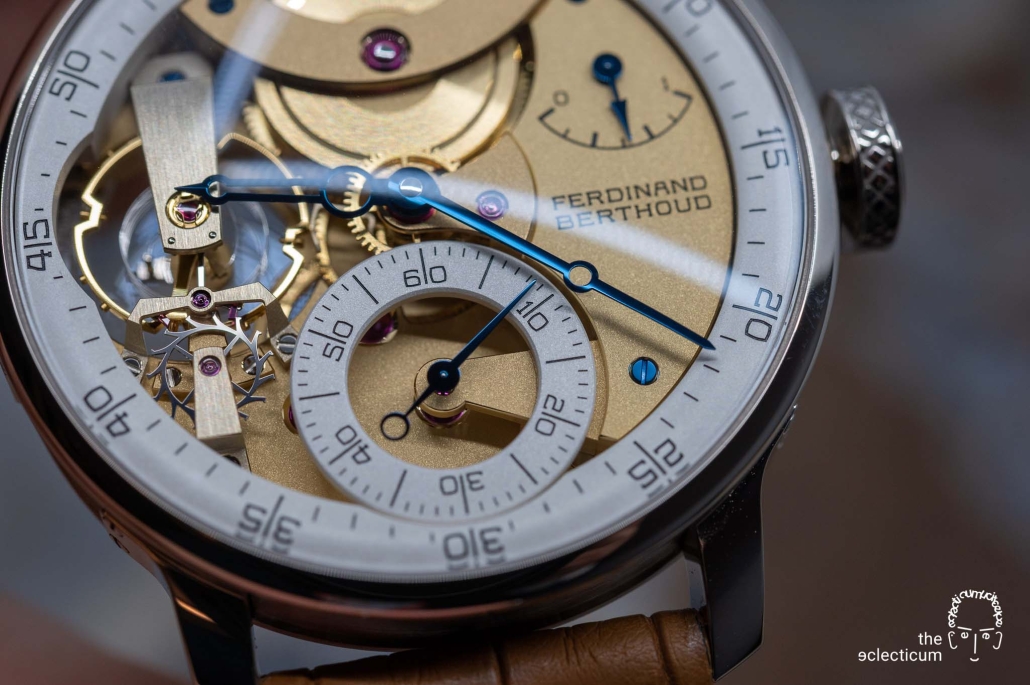
This new mechanical hand-wound movement stems from more than three years of research and development, during which every detail was carefully examined. Appearing at 9 o’clock, the three main escapement organs – the balance-wheel, pallet-lever and escape-wheel – are thus individualised, distinct and prominent. This ample space dedicated to the regulating organ enables its operation to be admired in full, and the cylindrical balance-spring to be seen beating throughout the three-day power reserve, including through a large water-resistant porthole created in the case middle at 9 o’clock. 


Stylistic filiation: a design inspired by pocket watches
While the FB 1 and FB 2 collections belong to the legacy of Ferdinand Berthoud’s marine chronometers, the FB 3 collection borrows from the style of the Master’s nephew, student and successor: Pierre-Louis Berthoud (1754-1813) known as “Louis Berthoud”. Born in 1754 in Couvet, in the Val-de-Travers, the latter moved to Paris at his uncle’s request. In 1784, having skilfully assisted in the making and improving of his distinguished relative’s marine chronometers, he was entrusted by Ferdinand Berthoud with the responsibility of his workshop, located since 1754 on Rue de Harlay, running along the Place Dauphine in Paris. 
Under his impetus, private watchmaking experienced considerable expansion. Louis Berthoud added his personal touch, which can be seen in the aesthetics of the mechanism. He inaugurated a style that was rooted in the highly functional appearance of marine chronometers, where function dictated form. He developed these pragmatic designs at a time when the spirit of the age was shifting from the baroque and opulent style of the monarchy to neo-classicism during the early days of the Republic and subsequently the Empire. Thanks to his exceptional talent, Louis Berthoud made the workshop’s activity bear fruit by naturally accompanying the societal and stylistic changes of his time. 
This inspiration is evident at first glance in the FB3 collection. Its new round case, available in 18-carat white or rose gold, recalls the curves of pocket watches from the early 19th century, such as the decimal watch No. 26, made in 1793 by Louis Berthoud and now on display within the Chronométrie Ferdinand Berthoud heritage collection in Fleurier.

A single line hugs the curves of the domed crystal and the slender polished bezel of the FB 3 models, while harmoniously extending along the strap and the lugs screwed to the case. 
This refined and coherent ensemble echoes the slimness of the case (42 mm in diameter and 9.43 mm thick), which fades into the background so as to make way for the spectacular movement.
Aesthetic affiliation: architecture designed to highlight every detail
The other deep-seated characteristic of Chronométrie Ferdinand Berthoud lies in the desire to create movements with a legible, graphic and three-dimensional architecture. The mainplate is placed at the heart of Calibre FB-SPC and the components are assembled on either side of it.
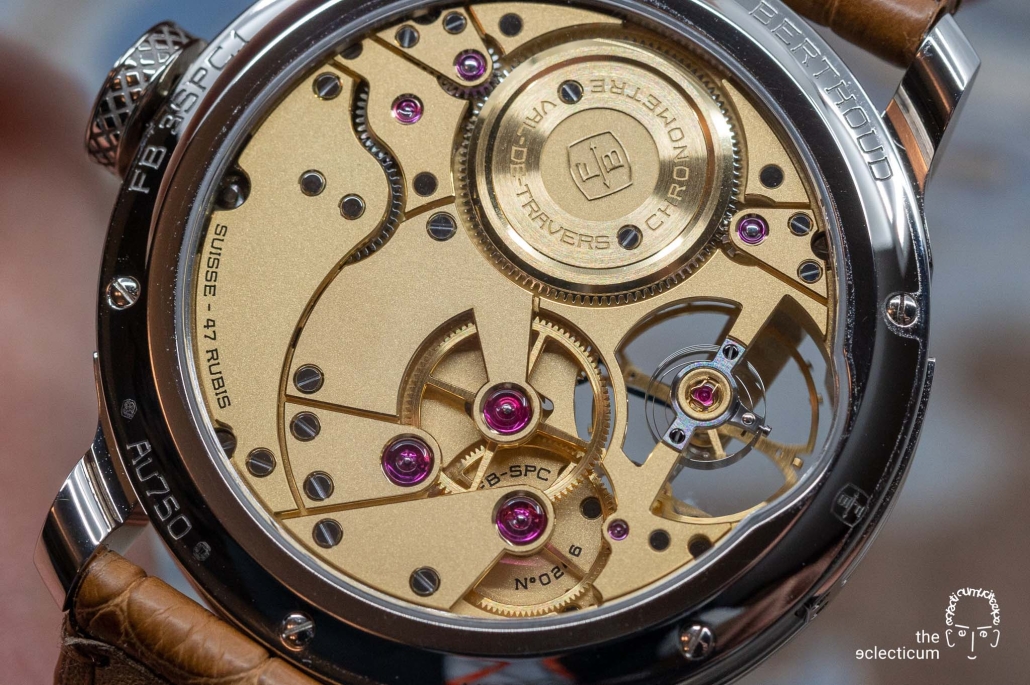
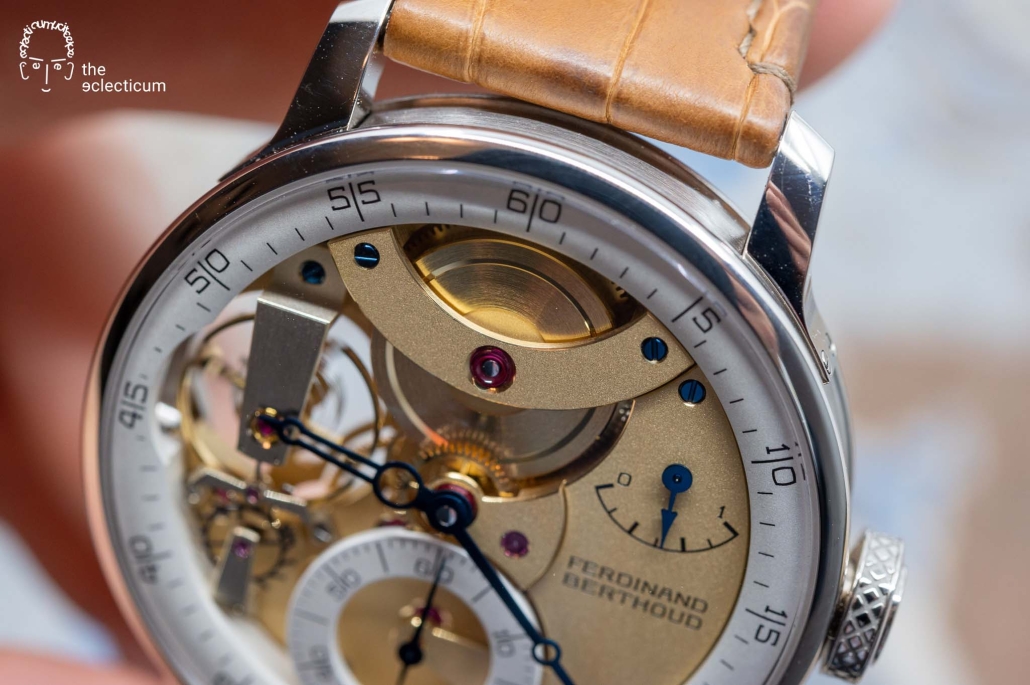
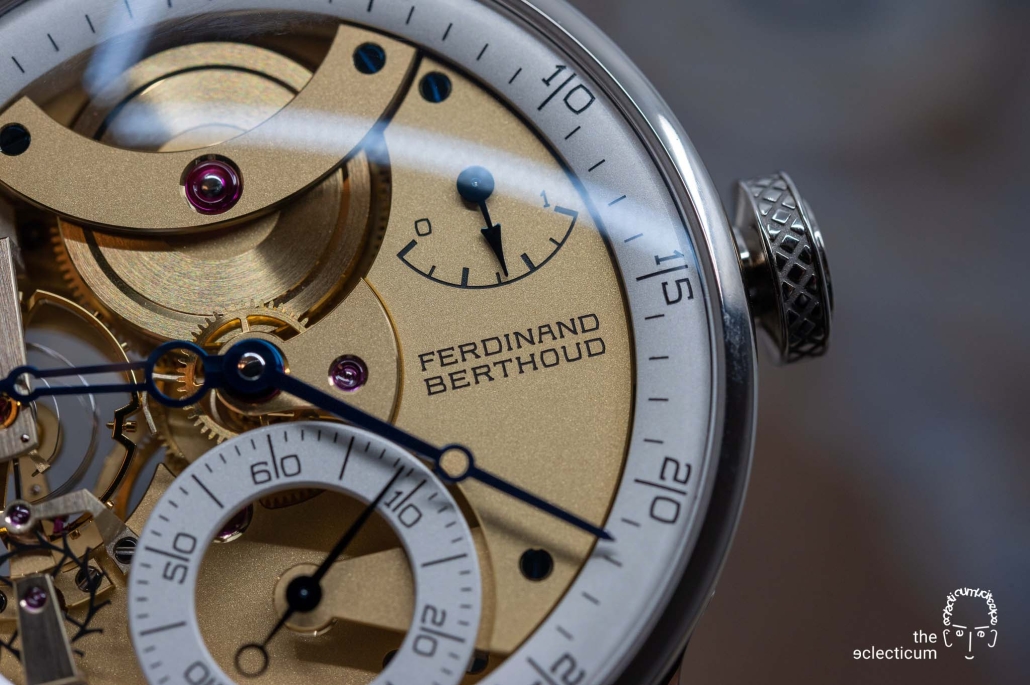
On the dial side, a close-knit array of six bridges traces curves and lines directly inspired by the work of Louis Berthoud. They are echoed on the back by ten other bridges forming an intimately juxtaposed mosaic.
The indication of time is pared down to the absolute minimum: a peripheral inner bezel ring for the hours and minutes, and small seconds at 6 o’clock. At 2 o’clock, the power-reserve indicator is engraved in a sector graduated in 12-hour segments from “0” to “1”. The rest of the dial, deliberately left open, enables one to admire the aesthetics of the movement’s components, their arrangement, as well as the surface conditions alternating between chamfered and polished bevels and matt surfaces created by fine sandblasting. The architecture of the movement is minimalist in appearance, yet no less complex. The hours and minutes flange, shaped like an amphitheatre, extends vertically to the mainplate. The openworked and suspended seconds disc is secured from below to a dedicated bridge. The balance-bridge, with its distinctive screw-in heel shape, is a historical reference to Ferdinand Berthoud’s No. 3 astronomical watch. Positioned at 12 o’clock, the barrel bridge spanning a wide 120° angle recalls a bridge on the No. 2575 quarter-repeater watch made by Louis Berthoud.
More than 100 hours are required to decorate the 230 components of the movement in order to achieve the ultimate degree of perfection characterising the creations bearing the Chronométrie Ferdinand Berthoud signature.
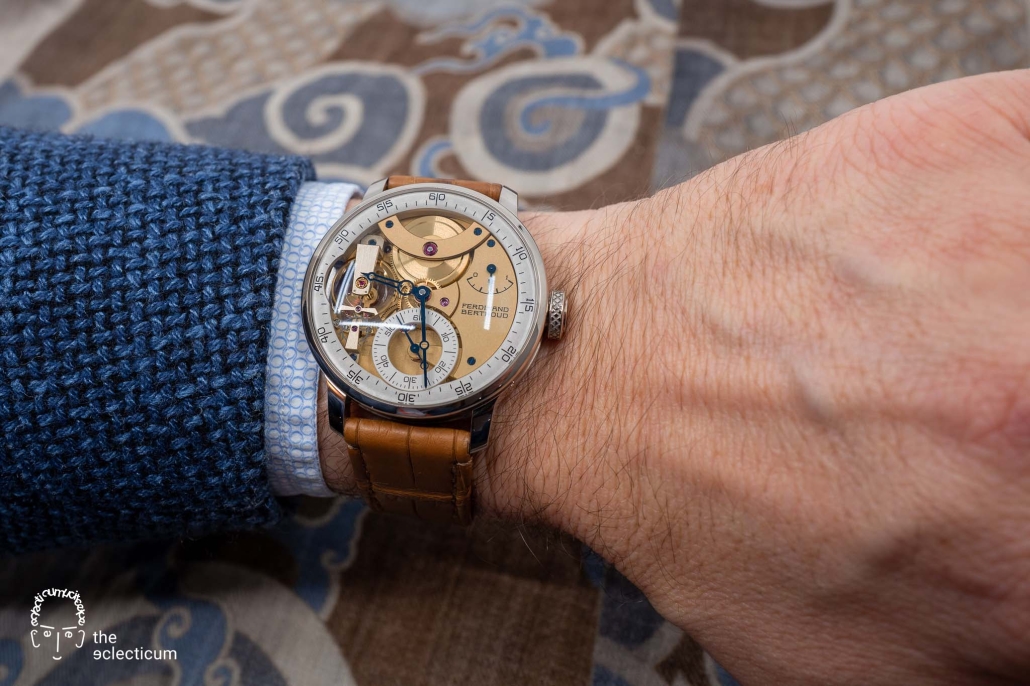


The Chronomètre FB 3SPC is available in two versions. The first features an 18-carat white gold case, 2N pale yellow gold movement components and an eggshell-coloured dial in sandblasted silver-toned brass. The second is equipped with an 18-carat 5N rose gold case framing a black-varnished minutes track with black-rhodium treated visible movement components. Their facetted, skeletonised and open-tipped 18-carat gold hands are inspired by a 1785 Ferdinand Berthoud astronomical regulator belonging to the Chronométrie Ferdinand Berthoud heritage collection in Fleurier.
The gold used in the production of Chronomètre FB 3SPC models stems from the ethical sourcing process instated by Karl-Friedrich Scheufele – President and Founder of Chronométrie Ferdinand Berthoud – at Chopard, of which he is also Co-President.
The Chronomètre FB 3SPC thus perpetuates one of the most emblematic stylistic elements of Louis Berthoud’s era, the post-revolutionary years of the early 19th century, when the pocket watch entered a new technical age. The Chronométrie Ferdinand Berthoud collection thus gains a new territory of expression, still rooted in historical chronometry, while its degree of finishing and its level of quality remain unchanged. Production of the Chronomètre FB 3SPC is naturally limited by the capacities of the Chronométrie Ferdinand Berthoud workshop in Fleurier to a maximum 25 of these timepieces per year.

In Detail: Hairspring Geometry
Two hand-crafted curves are necessary for the cylindrical spring: one at the point of attachment to the balance-wheel, and the other before the pin, which is integral with the balance-cock. The verticality of the balance-spring exposes it to important variations in its behaviour when it is in a horizontal position, i.e. when the watch case is perpendicular to the ground. This is why most modern cylindrical balance-springs are fitted inside tourbillons, which naturally compensate for these variations by their rotation. In this instance there is no tourbillon and the balance-spring is left to its own devices in the face of gravity. It is therefore up to the watchmakers at Chronométrie Ferdinand Berthoud to create chronometry within a more demanding environment, and so the two curves of the balance-spring are entirely raised by hand and their shape checked with the help of a microscope at 20x magnification.
This result was achieved after two years of research in the Chronométrie Ferdinand Berthoud workshops and independently validated. All the movements of the Manufacture are indeed submitted to the COSC. The first examples of the FB-SPC movement have thus logically undergone these same tests, which they have all passed with flying colours and will therefore all bear chronometer certification. However, the quality and precision requirements of Chronométrie Ferdinand Berthoud have always exceeded these standards. This is a personal requirement of Karl-Friedrich Scheufele, Co-President of Chopard in charge of watchmaking activities, as well as President and Founder of Chronométrie Ferdinand Berthoud. Therefore all prototypes of Calibre FB-SPC were also evaluated according to methods derived from the Fleurier Quality Foundation protocol. In addition, the range over which the chronometer-worthy timekeeping precision of the FB-SPC calibres is evaluated has been extended to 48 hours, instead of the 24 hours on which the COSC focuses. Finally, the calibre is fitted with a balance-stop device, which brings the small seconds to a halt so as to enable even more accurate time setting.
In Detail: Surfaces with hidden depths
The components of Calibre FB-SPC calibre all feature a matt surface, which is achieved by manual fine sandblasting. Their chamfers are cut and polished by hand before being coated with a galvanic surface treatment contrasting with the gold colour of the case. The result is FB 3SPC in white gold with 2N gilded movement components; alongside FB 3SPC.2 in rose gold with black-rhodium treated movement components.
After numerous tests and a particularly lengthy prototyping phase, Chronométrie Ferdinand Berthoud became more keenly aware than ever of the exclusive and unique nature of finishing work applied to its movements. The level of magnification at which these are executed and checked is in fact twice as high as the standards of Haute Horlogerie. Equipped with 6.7x magnifying glasses, the decoration operators are subjected to an unusual level of scrutiny. The individual style of each chamfering specialist is clearly perceptible. In order to create a consistent aesthetic throughout the whole movement, the decision was taken to ensure that each would be entirely decorated by one individual.
Like the FB1 and FB2 models before it, the Chronomètre FB 3SPC is an object born in the 21st century while enshrining meticulous care, authentic culture and watchmaking history. Its powerful and refined aesthetic draws on the codes of the mechanical timepieces that served as a benchmark for 18th century scientists. Its sophistication and finesse open up a new chapter in the history of Chronométrie Ferdinand Berthoud, one that promises a fine future and a wealth of subsequent developments.
A few thoughts/first impressions by ´the eclecticum`:
Once more it´s an intellectual exercise about ´Chronometry` – proofed by an official institution, which is not often given in the world of ´Haute Horlogerie` these days. The touch and feel (once more) is amazing and one could easily get lost observing all the details on offer. Still this time there are less details or better to say debaucheries if we compare it with watches from Chapter I and II – without any compromises when it comes to finishing you would expect from the brand Ferdinand Berthoud.
This is a very important notion on several levels: Sure, ‘less’ means it gets (slightly) more affordable and they can produce (slightly) more watches per year – but here ‘less’ does not reflect to quality! For example, you get a less complex case that still represents the style of the brand very well and on top may even better for smaller wrists because of its smaller size.
This is a very important notion to us as collectors and watch lovers: Ferdinand Berthoud delivers on their promise of excellent watchmaking and chronometry. A ‘simpler’ watch, defined by their choice of the means or the technology to achieves this, here the cylindrical balance spring, does not mean cost cutting on other important aspects like finishing. This is consistent and confirms the holistic view on their manufactur’s own identity (and thus range of products), and is one important characteristic of what we would classify as ´the pinnacle of fine watchmaking`, according to what we have laid out in our introductory article on this matter.
It follows from this that if you are in the market for such a watch you can safely choose any from Chapter I, II or III as it is foremost a matter of personal taste. Looking at the market of today even the term ´bargain` comes to our mind when we just look at the price tag of both (current) Chapter III pieces. Well, if we have the means for a treasure of that kind that is another question ?
Kudos to the team Ferdinand Berthoud, for their spirit and their products!
´the eclecticum`


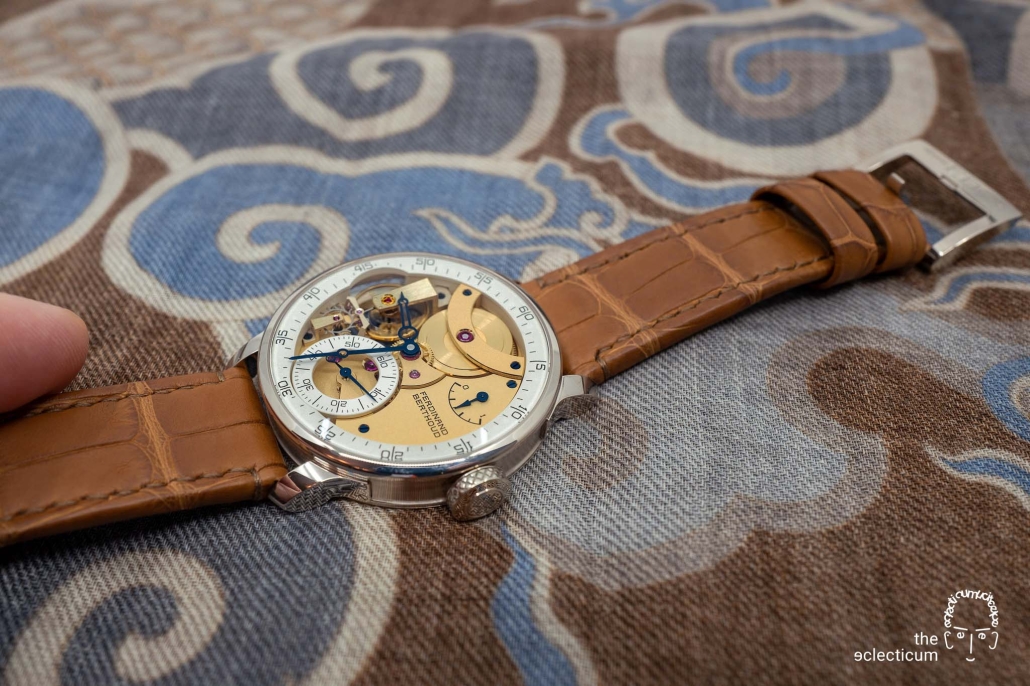
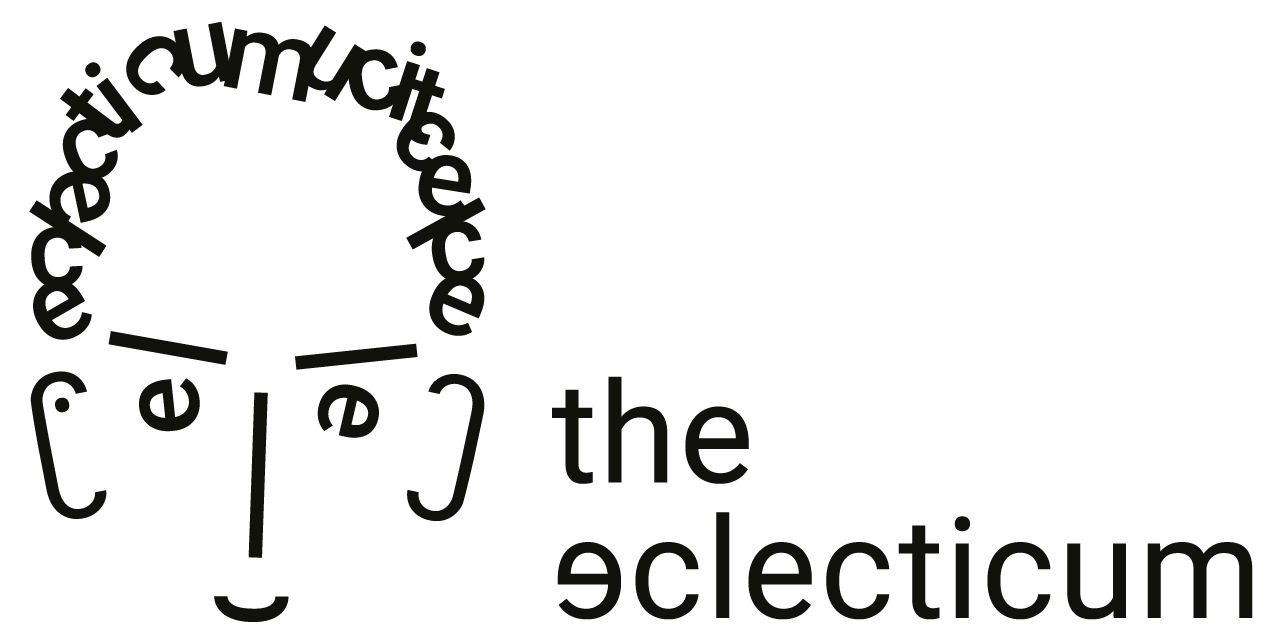


Good write-up. I absolutely lovee this site.
Stick witth it!